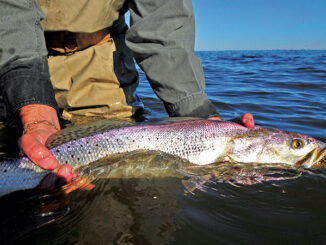
The chance for a speck of a lifetime entinces anglers to brave the elements in Big Lake
Why would anyone leave a perfectly comfortable bay boat, put on thermal underwear and socks, layer up and slip into insulated waders and then head into the frigid waters of Cacasieu Lake in the dead of winter?
Three words: Trophy speckled trout.
It’s not for the faint of heart, but if you lay awake at night thinking about reeling in a 6- or 7-pound speck, wading at Big Lake right now just might make your dreams come true.
Just last Thursday — with water temperatures at 58 degrees and falling with a passing cold front — Lake Charles’ Steven Bonsack and his clients exited their boat and stepped into a series of mixed shell and mud flats.
They caught and released 11 hefty trout, including two weighing more than 6 pounds, along with several other specks that pushed the Boga past the 4-pound mark.
“The Corky bite was on fire,” Bonsack said. “And an angler lost one that would have been 7-plus pounds.
“Not a single trout we caught and released was under 4 pounds.”
So far in 2016, Bonsack’s best fish has been a 28-inch, 7.3-pounder taken Jan. 5, and there have reportedly been two Calcasieu Lake 8-pounders taken this month by other wading anglers.
“Altogether, the crew I have been fishing with has taken approximately 20 over 6 pounds, four over 7 and one over 8,” Bonsack said.
Last season, the 32-year-old guide’s best trout was a 9.5-pounder taken in April during a wade. Although wade-fishing season officially starts in November, the better fish are generally taken now through the end of May.
“It’s going to get even better for the bigger trout,” Bonsack said. “The shrimp have about entirely left the system, and the larger specks are now targeting mullet aggressively.”
Once a trip is scheduled, Bonsack gives anglers the options of targeting numerous trout in the 14- to 18-inch range, or focusing exclusively on fewer but larger trout ranging 25 inches or better.
“The schooling trout (14 to 18 inches) will be in deeper waters when it’s cold, and there can be a lot of them,” he said. “On one wade trip, a group of us caught 100 fish — but not one was over 4 pounds.”
Bonsack said larger specks make shallow water excursions, unlike schools of smaller trout.
“They (larger trout) seek shallow mud and shell reefs,” he said. “They like a mixture of soft mud and shell, and during the winter they can get quite lethargic just lying in that mud like flounder waiting for mullet to come by.
“I like to compare them to a wolf pack instead of a school. They’re a smaller group of like-sized individuals just waiting to ambush the size of mullet you often see jumping on points and flats.”
As for likely locations to fish in Calcasieu Lake, Bonsack said the best wading occurs in mixed shell and mud flats located from Turner’s Bay south to Pelican Point. The large speckled trout can be found as shallow as 2 to 5 feet in these locations.
Tidal movement and the presence of mullet are factors to consider when choosing wading flats.
Water bottoms must be selected carefully, as there are soft mud locations where anglers can sink to their knees — although some of these hold big trout. Anglers definitely have to be careful treading in ankle- or waist-high depths to prevent falling into the cold water, which can quickly end a trip.
Most wade-fishing anglers prefer medium-fast rods for casting plugs, and Bonsack is no exception. He uses a 6-foot, 2-inch Wingman by Sarge Customs with a Shimano reel spooled with 30-pound PowerPro and a 30-pound Berkley Vanish fluorocarbon leader.
His 7.3-pounder earlier this month was taken on a natural broke-back Corky by Steve Brown, and he also casts Corky Peanuts and new Bugeye Corkys.
All of these lures are tied to the leader using a Rapala loop knot, which allows more action when the lure is suspended and twitched, or worked aggressively just below the water’s surface.
Bonsack said good insulated waders are necessary during cold-water trips, and should include a wading belt to hold a small container of lures, a Boga Grip, a small net and forceps for hook removal.
Depending on water temperature, thermal underwear and thermal socks under insulated fishing boots are also a good idea.
For guide information to wade at Big Lake, contact Bonsack at 713-825-7067, or call Adams Trophy Charters at 337-513-2760 and ask for Steven.


